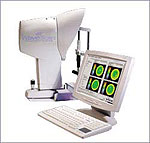Custom (Wavefront) vs. Standard Lasik Surgery
The terms "Custom", "Wavefront", or " Standard" LASIK are descriptions of the computer program used by the excimer laser to change the shape of the cornea.
Standard LASIK is the term now used for the older computer programs for the excimer laser. In these programs, the patient's glasses prescription was the main factor used by the computer to change the shape of the cornea. As such, two different patients who happened to wear the same glasses prescription would receive the same corneal shape change by the excimer laser. In contrast, Custom LASIK, which has been available since 2003, uses a much more sophisticated way of measuring the eye before surgery. A specialized map, or wavescan, is obtained using an instrument called an aberrometer.
 An aberrometer measures not only the glasses prescription, but also many other optical properties of the eye that cannot be measured by a simple glasses fitting. The result is an optical "fingerprint" of the patient's eye. The computer uses this data to correct all optical aberrations of the eye during the LASIK procedure. No two treatments, like fingerprints, are exactly alike between patients or even between the two eyes of one patient! Results from the clinical trials of Custom LASIK lasers show that more patients may achieve 20/20 or better vision with Custom LASIK than with the older Standard LASIK treatment.
An aberrometer measures not only the glasses prescription, but also many other optical properties of the eye that cannot be measured by a simple glasses fitting. The result is an optical "fingerprint" of the patient's eye. The computer uses this data to correct all optical aberrations of the eye during the LASIK procedure. No two treatments, like fingerprints, are exactly alike between patients or even between the two eyes of one patient! Results from the clinical trials of Custom LASIK lasers show that more patients may achieve 20/20 or better vision with Custom LASIK than with the older Standard LASIK treatment.
While Custom LASIK is probably the optimal way to reshape the cornea for vision correction, not all patients are candidates for Custom LASIK. Patients with very small pupil size, a high degree of astigmatism or myopia, or people interested in monovision treatments may fall outside the treatment ranges for Custom LASIK. Standard LASIK, however, is still a remarkably effective surgery, and offers a very good option for laser vision correction. The procedure for LASIK is essentially the same whether Standard or Custom excimer ablation is used.

